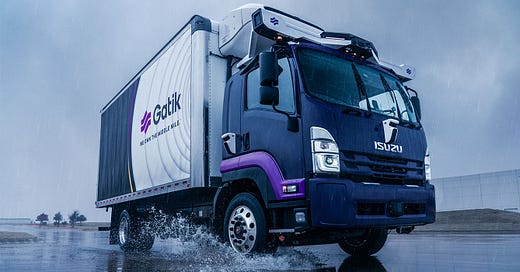The Ever Changing Landscape of Last-Mile Delivery and Logistics
How Gatik.ai is changing the game after a quarter million invested in the Mountain Valley native startup.
In a world where retail has the largest operational lift of all industries, the most expensive cost is the middle and last-mile deliveries. Middle and last-mile delivery accounts for the largest share of total delivery costs influenced by labor expenses, fuel costs, and inefficiencies in urban vs. rural routes. Sustainable delivery solutions, such as electric vehicle fleets, carbon footprint reduction technologies, and micro-mobility options, are becoming increasingly important.
The middle and last-mile delivery and logistics sector is rapidly evolving due to technological innovation and growing sustainability demands. Key trends shaping the industry include the integration of AI with autonomous navigation systems, the adoption of electric-powered vehicles, urban delivery robots, and the rise of smart logistics platforms that offer real-time route optimization and predictive delivery analytics.
The latest middle-mile startup to really shine as an innovative and extremely disruptive for all four key trends is Gatik.ai founded by Gautam Narang in 2017. Gatik is a B2B delivery and logistics company that provides more reliable, safe, and efficient service– without the need for a human driver. They are the Waymo of trucks and therefore fit in all four categories as they have fleets of trucks that are electric, autonomous vehicles and execute a smart logistics algorithm.
Gatik has carved out a specific niche within the autonomous vehicle market by focusing exclusively on B2B middle-mile logistics for retailers including Walmart. This targeted approach differentiates them from competitors pursuing long-haul trucking or last-mile delivery, allowing them to specialize in short-haul, repeatable routes between distribution centers and retail locations to train their trucks. In the same way Waymo trained their vehicles with a limited pathway to begin with is now taking over major cities in the United States including San Francisco, Los Angeles, and Austin to name a few. Gatik has focused on expanding starting with Texas, and Arkansas headquarters of legacy logistics companies like J.B.Hunt. Gatik intends to widen their geographical scope and expand throughout North American once safety certifications are complete.
The highest risk of the company is safety, there is a reason why Waymos are not running on highways yet. Gatik has prioritized this issue by developing a comprehensive Safety Assessment Framework certified by TÜV SÜD. This third party’s mission is to reduce the impact of technological risks and protect people, assets and the environment. Additionally, they created over 700 safety portfolios that must be completed before scaling driverless operations. Scaling can only be successful after a series of passed trips without any discrepancies.
Slowly but surely after raising a total of $273.49M they’ve begun to scale operations and increased their valuation to $810.00M. The capital it took to uplift and be in market is extremely substantial and after a quarter of a million dollars are we starting to see the benefits. The operational costs are now decreasing significantly because concerns like fuel and drivers are no longer a factor.
According to Gatik's CEO Gautam Narang, the company's autonomous trucking solutions aim to help retailers save up to 30% in operating costs in the long term. This is significant because the short-haul segment between warehouses and stores—where Gatik operates—is traditionally one of the least optimized and most expensive parts of the supply chain, accounting for 30-40% of total delivery costs .
While specific savings figures for individual clients like Walmart, Kroger, Loblaw, and Tyson Foods aren't publicly disclosed, Gatik notes that “the savings accumulated from autonomous operations across a 1,000-location network unlocks millions of dollars annually.” These cost savings are particularly valuable in the current economic environment where retailers are facing margin pressures from inflation and potential tariff increases.
Beyond direct cost savings, Gatik also emphasizes that their autonomous delivery service provides additional benefits that impact retailers' bottom lines:
Increased delivery frequency and store replenishment rates
Enhanced supply chain reliability
Reduced congestion in logistics networks
More consistent deliveries
These operational improvements help retailers maintain competitive pricing and avoid passing rising costs to consumers, which is particularly important for maintaining customer loyalty during periods of economic pressure.
For investors, success hinges on focusing on scalable AI and automation technologies, sustainable logistics, and cross-border expansion opportunities, while carefully evaluating unit economics and regulatory compliance. Innovators are encouraged to develop flexible, sustainable delivery solutions, integrate AI and machine learning, enhance customer experience, and establish strategic partnerships to drive operational efficiency.
Overall, companies like Gatik that effectively combine advanced technology, operational efficiency, and environmental consciousness-while maintaining strong unit economics-are best positioned to lead in this dynamic market. Now the question that keeps circulating is as this continues to acquire the market how will truck driver unions react and how will this impact legacy logistics companies like J.B.Hunt?





